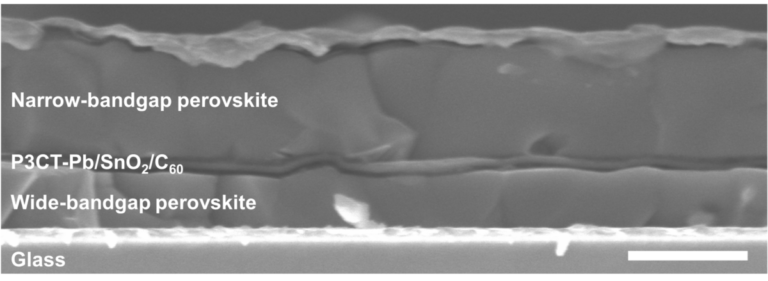Scientists in the United States have fabricated an all-perovskite tandem solar cell that reportedly exhibits reduced interfacial energy loss in the cell’s top device. It was built with a hole transport layer based on a compound known as P3CT that was doped with lead iodide.
A group of researchers led by the University of Toledo in the United States has fabricated an all-perovskite tandem solar cell with a wide bandgap top cell based on tin-lead (Pb-Sn) perovskite and a low bandgap. bottom cell based on a conventional perovskite substrate.
“The technology readiness level (TRL) of the tandem device examined in this study is still low with TRLs 2-3,” said the study’s corresponding author Zhaoning Song. pv magazine. “However, our work proves the feasibility of improving the stability of all-perovskite tandem solar cells, but more work needs to be done to apply this technique to industrial production.”
The key feature of the tandem cell is the hole transport layer (HTL) of the top device, which is fabricated with a Pb-doped compound known as poly[3-(4-carbox- ybutyl)thiophene-2,5-diyl] (P3CT), a material reported to provide excellent stability and relatively high hole mobility.
“We introduce Pb doping to increase its work function and minimize energy level compensation with the Sn-Pb perovskite,” the academics explained, noting that P3CT is a valid alternative to the commonly used PEDOT-PSS. “The Pb dopants also provide nucleation sites to enable high-quality Sn-Pb perovskite film growth.”
The group built the top cell with a substrate made of indium tin oxide (ITO), the new HTL, the Sn-Pb perovskite absorber, an electron transport layer (ETL) based on buckminsterfullerene (C60), a bathocuproin (BCP) buffer layer and a silver (Ag) metal contact.
The champion cell built with this architecture achieved a power conversion efficiency of 22.7%, an open-circuit voltage of 0.884 V, a short-circuit current density of 32.0 mA cm2, and a fill factor of 80.3%. It was then combined in a tandem device with an 18.7% efficient bottom cell based on a perovskite absorber with a band gap of 1.7 eV, an HTL made from a phosphonic acid called methyl substmodified carbazole (Me-4PACz) and an ETL relying on C60.
The champion P3CT-based tandem achieved an efficiency of 27.8, an open-circuit voltage of 2.147 (2.146) V, a short-circuit current density of 15.7 mA/cm2 and a fill factor of 82.6%.
“The P3CT-based tandems also exhibit a higher average efficiency of 27.0% than PEDOT:PSS-based devices, proving excellent reproducibility of the high-efficiency tandems with the P3CT-Pb HTL,” the group pointed out. “Doping P3CT with Pb cations reduced the valence band offset with Sn-Pb perovskite and provided nucleation seeds for improving perovskite crystallization, resulting in improved film quality.”
The P3CT-based tandem was found to retain approximately 97% of its initial efficiency even after 1000 hours.
According to Song, the cost of the doping technique is virtually negligible, since the lead iodide material used for doping is the same source material used for producing the perovskite absorbing layer, and only a trivial amount is required for doping. “Still, it is worth noting that the polymer hole transport material used in this study is still expensive due to the complexity of the synthesis and the limited production scale,” he further explains.
The new cell technology was introduced in the study “Suppressed deprotonation enables a durable buried interface in tin-lead perovskite for all-perovskite tandem solar cells,” published in Joule. “Our molecular design strategy for stabilizing the perovskite/HTL interface provides a direction for achieving efficient and stable all-perovskite tandem solar cells,” the team concluded.
This content is copyrighted and may not be reused. If you would like to collaborate with us and reuse some of our content, please contact: editors@pv-magazine.com.


